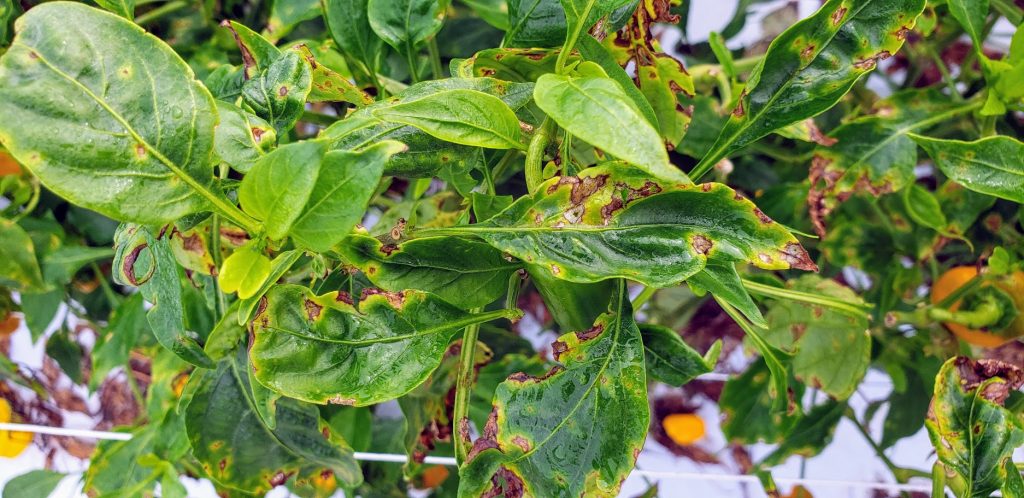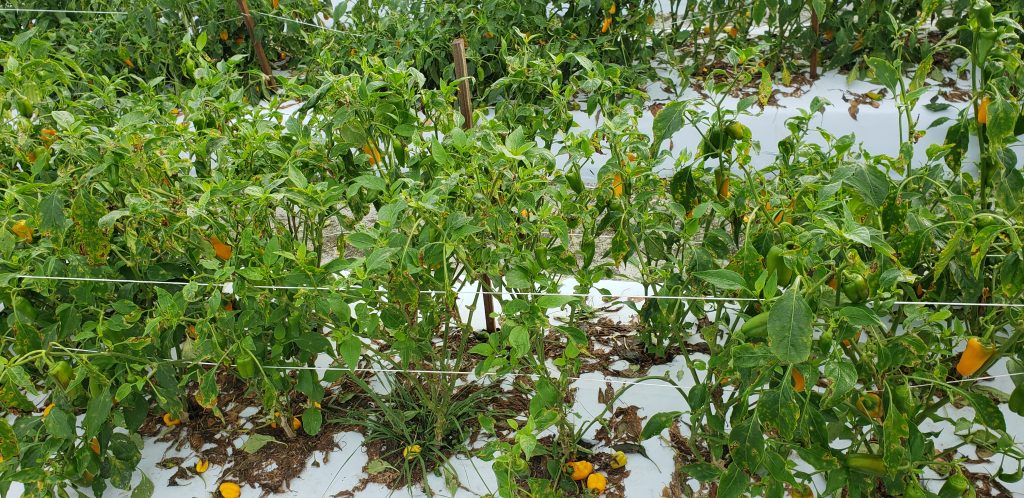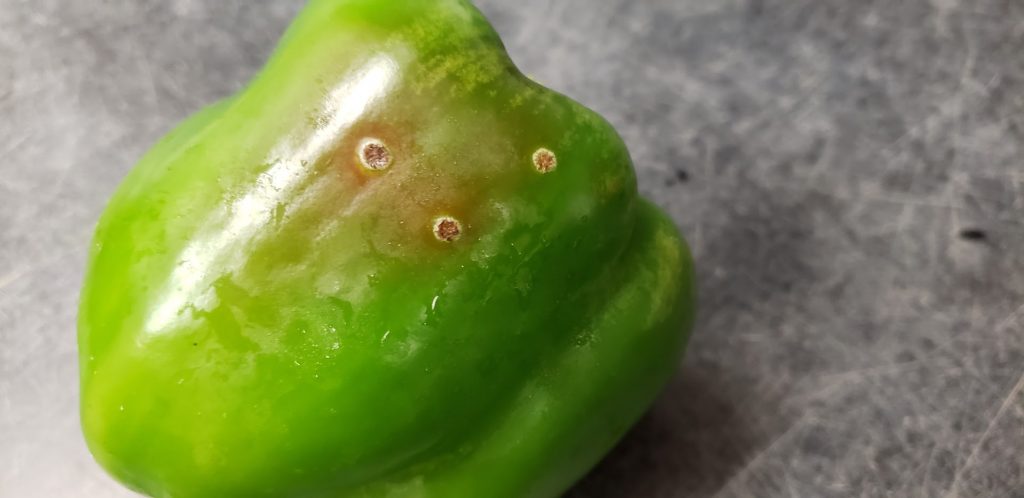
By Pamela Roberts and Cami Esmel McAvoy
Bell and specialty peppers, such as jalapeños, are grown throughout the United States and worldwide for the fresh market or processing. Bacterial spot, caused by three different species of Xanthomonas, is a major disease affecting all pepper types. The most commonly occurring species in the United States and Florida is Xanthomonas euvesicatoria. The other two species, X. perforans and X. gardneri, are not frequently found on pepper but occur more commonly on tomato.
Disease Symptoms

Bacterial spot is such a common, chronic disease problem that most pepper growers are already familiar with the symptoms. Bacterial spot lesions occur on plant stems, leaves and fruit.
Lesions on leaves begin as water-soaked, greasy-like spots that turn light brown and then dark brown as the tissue dies (Figure 1). The leaf lesions will frequently coalesce to cover large portions of infected leaves. Even with light disease, the leaves will often drop off the plant leaving all but the top of the pepper plant defoliated (Figure 2). When this happens, the plant is less vigorous, and the fruit are exposed to sunburn.
The bacteria can also cause lesions on fruit that cause the fruit to be non-marketable. On the fruit, initial symptoms are small, raised lesions that are a lighter color than the rest of the fruit. Eventually the lesions darken and turn from brown to black (Figure 3). Fruit infected with bacterial spot are more likely to be susceptible to secondary invasion of other pathogens such as soft rot bacteria.
Survival and Spread
Bacterial spot can initiate from bacteria survival on seed, alternative hosts or plant debris. When seed is the source of infection, symptoms can occur on transplants in the production house. Infected plants should be discarded and not taken to the field. The bacteria can survive in the environment on volunteer pepper plants, other related plants such as tomato, or on the surface of non-host plants such as weeds.

Once plants are infected, secondary bacterial inoculum can be moved with moisture such as wind-splashed rain or dew runoff. Workers or equipment can also move the bacteria when the plants are wet. Warm and moist conditions such as those occurring during the rainy season are favorable for disease development.
Management Methods
As with other pests, tactics to reduce damage from bacterial spot on pepper use integrated pest management. This approach uses all available tools including host resistance, cultural and sanitation methods, and spray materials.
Fortunately, sources of resistance genes are available and bred into many commercial bell peppers. Various combinations of the resistance genes can be present in a variety to give resistance to all known races of X. euvesicatoria. Many of the specialty and chili pepper varieties have not been bred with the resistance genes. Resistant varieties should be used whenever possible. Since the bacteria are seed borne, use of certified disease-free seed is recommended.
As with other pests, scouting is essential to identify and target management decisions both in the transplant house and field. Transplants and plants should be scouted regularly. Use only healthy transplants in the field. Since the bacteria can survive on volunteer and non-host plants, fields should be prepped to remove potential sources of inoculum at the beginning of the season. At the end of the season, the crop should be removed promptly to reduce inoculum-harboring debris.
Despite surveys in the past which found wide distribution of copper-resistant bacterial strains, copper bactericides combined with a dithiocarbamate fungicide, such as mancozeb, were still effective in recent field trials to reduce the severity of bacterial spot on pepper. Surveys initiated in the past few years are assessing the current population of Xanthomonas species across many different pepper types and varieties to determine the state of copper resistance. Since copper tolerance in the bacterial spot pathogen is qualitative and not quantitative, it is still used in most operations including organic production.
In addition to copper and mancozeb formulations, several biopesticides are labeled for bacterial spot control on pepper. As part of a U.S. Department of Agriculture (USDA) Specialty Crop Research Initiative grant involving participants across five states, the University of Florida Institute of Food and Agricultural Sciences (UF/IFAS) is coordinating trials to evaluate the efficacy and consistency of control of many of these products in multiple field trials and locations. Results from some of these preliminary trials, such as the one completed in South Florida, show that several biological and organic compounds are effective in reducing bacterial spot severity. However, consistent with results of previous trials, copper/mancozeb is still effective and recommended as a component of a spray program.
Acknowledgment: The authors acknowledge USDA Specialty Crop Research Initiative project award 2019-51181-30010 for funding.
Pamela Roberts is a professor and Cami Esmel McAvoy is an assistant research scientist, both at the UF/IFAS Southwest Florida Research and Education Center in Immokalee.
Control Tips
- If the population of Xanthomonas euvesicatoria is known, choose a variety with resistance genes specific to that population.
- Avoid magnesium foliar and soil applications, as these have been shown to increase disease severity.
- Acibenzolar-S-methyl, a systemic acquired resistance inducer, is only labeled for non-bell and hot peppers.









